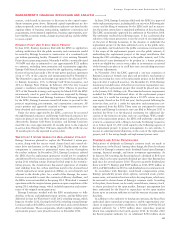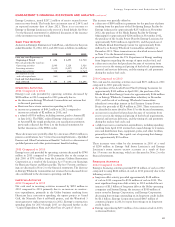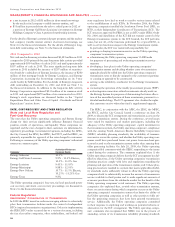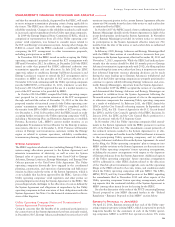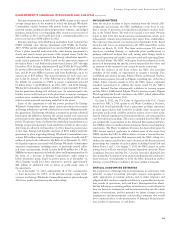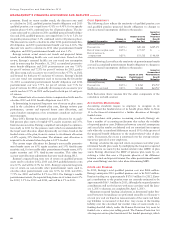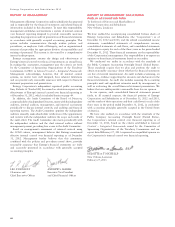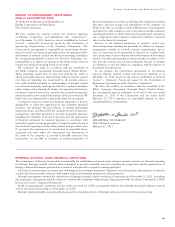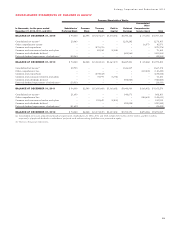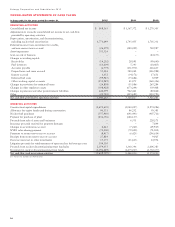Entergy 2012 Annual Report Download - page 46
Download and view the complete annual report
Please find page 46 of the 2012 Entergy annual report below. You can navigate through the pages in the report by either clicking on the pages listed below, or by using the keyword search tool below to find specific information within the annual report.Entergy Corporation and Subsidiaries 2012
MANAGEMENT’S FINANCIAL DISCUSSION AND ANALYSIS continued
Nuclear Decommissioning Costs
Entergy subsidiaries own nuclear generation facilities in both the
Utility and Entergy Wholesale Commodities business units. Regu-
lations require Entergy subsidiaries to decommission the nuclear
power plants after each facility is taken out of service, and money
is collected and deposited in trust funds during the facilities’ operat-
ing lives in order to provide for this obligation. Entergy conducts
periodic decommissioning cost studies to estimate the costs that will
be incurred to decommission the facilities. The following key assump-
tions have a significant effect on these estimates:
n COST ESCALATION FACTORS – Entergy’s current decommis-
sioning cost studies include an assumption that decommissioning
costs will escalate over present cost levels by factors ranging from
approximately 2.0% to 3.25%. A 50 basis point change in this
assumption could change the estimated present value of the decom-
missioning liabilities by approximately 10% to 18%. To the extent
that a high probability of license renewal is assumed, a change in the
estimated inflation or cost escalation rate has a larger effect on the
undiscounted cash flows because the rate of inflation is factored into
the calculation for a longer period of time.
n TIMING – In projecting decommissioning costs, two assumptions
must be made to estimate the timing of plant decommissioning.
First, the date of the plant’s retirement must be estimated. A high
probability that the plant’s license will be renewed and the plant
will operate for some time beyond the original license term has
currently been assumed for purposes of calculating the decommis-
sioning liability for a number of Entergy’s nuclear units. Second,
an assumption must be made whether decommissioning will begin
immediately upon plant retirement, or whether the plant will be
held in SAFSTOR status for later decommissioning, as permitted
by applicable regulations. SAFSTOR is decommissioning a facil-
ity by placing it in a safe, stable condition that is maintained until
it is subsequently decontaminated and dismantled to levels that
permit license termination, normally within 60 years from perma-
nent cessation of operations. While the effect of these assumptions
cannot be determined with precision, a change of assumption of
either the probability of license renewal, continued operation, or
use of a SAFSTOR period can possibly change the present value of
these obligations. Future revisions to appropriately reflect changes
needed to the estimate of decommissioning costs will immediately
affect net income for non-rate-regulated portions of Entergy’s busi-
ness, and then only to the extent that the estimate of any reduction
in the liability exceeds the amount of the undepreciated asset retire-
ment cost at the date of the revision. Any increases in the liability
recorded due to such changes are capitalized as asset retirement
costs and depreciated over the asset’s remaining economic life.
n SPENT FUEL DISPOSAL – Federal law requires the DOE to pro-
vide for the permanent storage of spent nuclear fuel, and legisla-
tion has been passed by Congress to develop a repository at Yucca
Mountain, Nevada. However, hearings on the repository’s NRC
license have been suspended indefinitely. The DOE has not yet
begun accepting spent nuclear fuel and is in non-compliance with
federal law. The DOE continues to delay meeting its obligation
and Entergy is continuing to pursue damages claims against the
DOE for its failure to provide timely spent fuel storage. Until a
federal site is available, however, nuclear plant operators must
provide for interim spent fuel storage on the nuclear plant site,
which can require the construction and maintenance of dry cask
storage sites or other facilities. The costs of developing and main-
taining these facilities during the decommissioning period can
have a significant effect (as much as an average of 20% to 30% of
total estimated decommissioning costs). Entergy’s decommission-
ing studies may include cost estimates for spent fuel storage.
However, these estimates could change in the future based on the
timing of the opening of an appropriate facility designated by the
federal government to receive spent nuclear fuel.
n TECHNOLOGY AND REGULATION – Over the past several years,
more practical experience with the actual decommissioning of
facilities has been gained and that experience has been incor-
porated into Entergy’s current decommissioning cost estimates.
However, given the long duration of decommissioning projects,
additional experience, including technological advancements in
decommissioning, could occur and affect current cost estimates.
If regulations regarding nuclear decommissioning were to change,
this could have a potentially significant effect on cost estimates.
The effect of these potential changes is not presently determinable.
n INTEREST RATES – The estimated decommissioning costs that
form the basis for the decommissioning liability recorded on the
balance sheet are discounted to present values using a credit-
adjusted risk-free rate. When the decommissioning cost estimate is
significantly changed requiring a revision to the decommissioning
liability and the change results in an increase in cash flows, that
increase is discounted using a current credit-adjusted risk-free
rate. Under accounting rules, if the revision in estimate results in a
decrease in estimated cash flows, that decrease is discounted using
the previous credit-adjusted risk-free rate. Therefore, to the extent
that one of the factors noted above changes resulting in a signifi-
cant increase in estimated cash flows, current interest rates will
affect the calculation of the present value of the additional decom-
missioning liability.
In the second quarter 2012, Entergy Louisiana recorded a revision to
its estimated decommissioning cost liability for Waterford 3 as a result
of a revised decommissioning cost study. The revised estimate resulted
in a $48.9 million increase in its decommissioning cost liability, along
with a corresponding increase in the related asset retirement costs asset
that will be depreciated over the remaining life of the unit.
In the second quarter 2012, Entergy Wholesale Commodities
recorded a reduction of $60.6 million in the estimated decommission-
ing cost liability for a plant as a result of a revised decommissioning
cost study. The revised estimate resulted in a credit to decommission-
ing expense of $49 million, reflecting the excess of the reduction in
the liability over the amount of the undepreciated asset retirement
costs asset.
In the first quarter 2011, System Energy recorded a revision to its
estimated decommissioning cost liability for Grand Gulf as a result
of a revised decommissioning cost study. The revised estimate resulted
in a $38.9 million reduction in its decommissioning liability, along
with a corresponding reduction in the related regulatory asset.
In the fourth quarter 2011, Entergy Wholesale Commodities recorded
a reduction of $34.1 million in its decommissioning cost liability for
a plant as a result of a revised decommissioning cost study obtained
to comply with a state regulatory requirement. The revised cost study
resulted in a change in the undiscounted cash flows and a credit to
decommissioning expense of $34.1 million, reflecting the excess of the
reduction in the liability over the amount of undepreciated assets.
Unbilled Revenue
As discussed in Note 1 to the financial statements, Entergy records an
estimate of the revenues earned for energy delivered since the latest
customer billing. Each month the estimated unbilled revenue amounts
are recorded as revenue and a receivable, and the prior month’s esti-
mate is reversed. The difference between the estimate of the unbilled
receivable at the beginning of the period and the end of the period
is the amount of unbilled revenue recognized during the period. The
estimate recorded is primarily based upon an estimate of customer
usage during the unbilled period and the billed price to customers in
44



